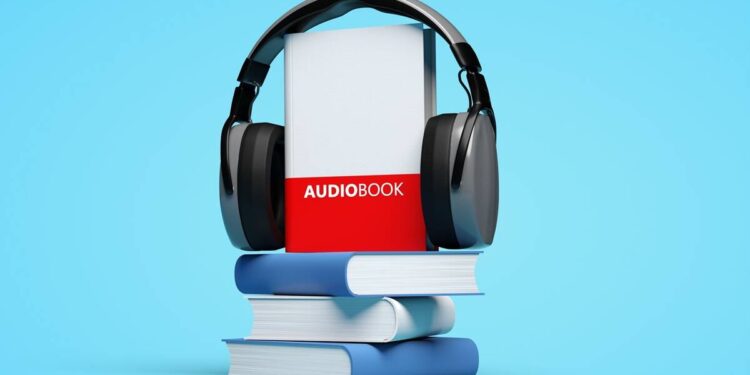Table of Contents
ToggleIntroduction
The Rise Of Audiobooks Literature In A Digital Age Audiobooks have seen a sharp increase in popularity over the last ten years, swiftly taking the lead in the literary industry. Previously seen as a specialized market, audiobooks are increasingly used by readers of various backgrounds, including commuters, students, those with visual impairments, and traditional book enthusiasts.
Because of the ease of use of smartphones, streaming services, and voice-activated assistants, as well as the quick advancement of digital technology, audiobooks are now more widely available than ever. A strong ecosystem for audiobook enthusiasts has been established by the growth of subscription services and streaming choices, as well as audiobook sites like Audible, Google Play Books, and Apple Books.
In addition to changing the book industry, this change in how we read has also had an impact on how we perceive stories. Listeners are no longer limited to reading on paper on a screen thanks to audiobooks. Literature is now more ingrained in everyday life than ever before since people can lose themselves in a book while working out, driving, or doing housework.
The advantages of audiobooks over traditional reading, the technological advancements that have fueled this trend, and the societal shifts brought about by this new storytelling medium will all be covered as we delve deeper into the emergence of audiobooks. We will also look at the reasons audiobooks are here to stay and the effects they are having on authors, listeners, and the publishing industry.
The Evolution of Audiobooks: From Cassette Tapes to Streaming
The history of audiobooks dates back to the early 20th century. However, it wasn’t until the 1980s and 1990s that audiobooks began to emerge as a mainstream format. Early audiobooks were primarily available on cassette tapes and, later, CDs. These were often used by people with visual impairments or those who wanted a more convenient way to access books during travel. In the 1990s, audiobooks began to grow in popularity among commuters, as people used their time in transit to listen to stories.
The real turning point came in the 2000s with the rise of digital technology. The advent of MP3 players and later, the widespread use of smartphones, revolutionized how audiobooks were consumed. The digital format made it easier to purchase, store, and listen to audiobooks on the go.
Read More
Platforms like Audible, which launched in 1995, capitalized on this growing demand, allowing users to download and listen to audiobooks directly from their devices. The shift from physical media to digital downloads paved the way for subscription services, where users could access an entire library of books for a monthly fee, similar to how streaming services like Netflix revolutionized television.
The development of streaming services like Audible, Spotify, and Apple Books in the last decade has further transformed the audiobook landscape. These platforms not only offer audiobooks for individual purchase or subscription but also provide podcasts, lectures, and other audio content. This expansion has made audiobooks an increasingly significant part of the larger digital audio ecosystem.

Why Audiobooks Are So Popular
1. Convenience and Multitasking
One of the primary reasons for the rise of audiobooks is the convenience they offer. The ability to listen to a book while performing other tasks has revolutionized how people engage with literature. Commuters, parents, and professionals can listen to books during their daily routines, turning seemingly wasted time into an opportunity for personal enrichment. Audiobooks allow people to engage with literature during activities like cooking, exercising, or even cleaning the house, creating a seamless integration of reading into everyday life.
Audiobooks also allow listeners to “read” while doing things that would be difficult to do with a physical or digital book, such as driving or walking. For busy individuals, audiobooks make it easier to consume books that might otherwise be difficult to fit into a packed schedule.
2. Accessibility for All
Audiobooks have had a transformative effect on people with disabilities, particularly those with visual impairments or reading disabilities such as dyslexia. For individuals who struggle with traditional forms of reading, audiobooks offer a way to access literature independently and enjoy the same material as sighted readers. Audiobook technology has made it possible for people who previously might have had limited access to books to experience stories in a more inclusive and enriching way.
In addition, audiobooks help broaden access to information for those with learning disabilities. Audiobooks often come with features such as adjustable playback speed or a feature that highlights the text as it is read, which can support comprehension for listeners with learning disabilities like dyslexia.
3. Narration and Performance
Audiobooks stand out due to their unique auditory experience. Unlike traditional reading, listening to an audiobook brings an additional layer of performance to the text. Narrators—often professional actors or voice talents—infuse stories with emotion, tone, and character voices that add a new dimension to the reading experience. For some genres, such as mysteries or thrillers, this performance aspect heightens the tension and suspense, making the experience of listening more engaging than reading the text alone.
Audiobook narrators bring the characters and dialogue to life in a way that can transform the book into a more vivid, immersive experience. Many listeners enjoy hearing how narrators interpret characters and use their voices to convey emotions, inflections, and the mood of a scene. In some cases, well-known actors or celebrities may narrate audiobooks, further enhancing their appeal. For instance, celebrity narrators like Maggie Gyllenhaal, Tom Hanks, and Stephen Fry have contributed to audiobooks, giving them a high level of star power.
4. Broader Selection of Content
The digital revolution has expanded the types of books available in audio format. What was once a limited selection of classics and bestsellers has now become a vast array of genres, including fiction, non-fiction, memoirs, poetry, self-help, business, and educational books. Audiobook libraries are continually growing, and consumers now have access to everything from the latest blockbusters to niche genres and independent publications.
Many small and independent authors are also turning to audiobooks as a platform for self-publishing. This growing accessibility for authors has led to an influx of new and diverse voices in the audiobook market. As a result, listeners are finding fresh perspectives and stories they might not have encountered otherwise, expanding the variety and inclusivity of audiobooks.
Read More
5. Immersive and Enhanced Storytelling
Audiobooks have evolved beyond simple readings of texts to become full-fledged experiences. Many modern audiobooks include sound effects, music, and sometimes multiple narrators to create a fully immersive atmosphere. These enhanced audiobooks often include added layers of storytelling, transforming the listening experience into a multimedia event. For example, audiobooks of fantasy novels may include background sounds of nature, battle scenes, or magical sound effects, enriching the story’s world-building and atmosphere.
Enhanced audiobooks push the boundaries of the medium, making listening a dynamic experience. This level of storytelling sophistication is especially appealing to younger generations, who are accustomed to interactive, multi-sensory forms of entertainment, such as video games and films.
The Impact of Audiobooks on the Publishing Industry
The rise of audiobooks has had significant effects on the publishing industry. Audiobooks now represent a major portion of the market, with sales growing exponentially in recent years. This shift is not only influencing the way books are marketed and sold but also shaping how authors create and structure their works. Many authors are now considering how their books might translate into audio form, and publishers are increasingly investing in audiobook production.
Moreover, audiobook sales have opened up new revenue streams for both large publishing houses and independent authors. Traditionally, book sales relied heavily on print formats, with e-books only gradually gaining a foothold in the digital age. Today, audiobooks represent a substantial market segment, contributing to publishers’ bottom lines. This growth has also prompted greater innovation within the industry, as audiobook platforms like Audible partner with publishers, authors, and even celebrities to create exclusive audio content.
The increasing popularity of audiobooks also has implications for the future of libraries. Public libraries are embracing audiobooks as part of their digital lending collections. Many libraries offer free access to audiobooks through apps such as Libby or OverDrive, allowing library cardholders to borrow audiobooks as easily as traditional e-books or print books.
Challenges and Criticisms of Audiobooks
Despite the rapid rise of audiobooks, there are still some challenges and criticisms that need to be addressed. One significant issue is the cost. Audiobooks tend to be more expensive than their print or e-book counterparts, which can be a barrier for some readers. Subscription services, while affordable, still require a monthly commitment, and not all books are available through these services. Furthermore, some critics argue that audiobooks do not offer the same deep engagement or satisfaction as reading a physical book, with some feeling that listening may be a passive activity compared to actively engaging with text.
Additionally, there are concerns that the ease and convenience of audiobooks might diminish people’s ability to focus and engage in deep, sustained reading. The auditory nature of audiobooks means that listeners are multitasking, which could detract from the ability to fully immerse oneself in a text. This leads to ongoing debates about the nature of reading and whether listening to an audiobook can be considered the same as reading.

Conclusion
The rise of audiobooks is an exciting chapter in the history of literature, one that demonstrates the adaptability of storytelling in the digital age. With the help of technology, audiobooks have made literature more accessible, more convenient, and more immersive than ever before. Whether you are a commuter, a busy professional, or someone looking for a more inclusive way to experience literature, audiobooks offer a versatile medium that has become an integral part of the modern literary landscape.
As we continue to move further into the digital age, audiobooks will likely remain an important part of the way we consume stories, offering unique opportunities for engagement and creativity. The future of audiobooks is bright, with constant innovation in narration, audio production, and distribution methods. For readers and listeners alike, audiobooks offer an exciting new way to experience literature in a constantly evolving, digital world.
Read More
FAQ
1. Are audiobooks better than traditional books?
Whether audiobooks are better than traditional books depends on personal preference. Audiobooks offer convenience, especially for those who multitask or have limited time for traditional reading. However, some readers prefer the tactile experience and deeper engagement that comes with physical books or e-books.
2. How do I get started with audiobooks?
To start listening to audiobooks, you can download audiobook apps such as Audible, Google Play Books, or Apple Books. Many libraries also offer free audiobook borrowing through apps like Libby or OverDrive. Subscriptions to audiobook services often include one or more free credits each month.
3. Are audiobooks available in all genres?
Yes, audiobooks are available in a wide range of genres, including fiction, non-fiction, self-help, business, fantasy, and more. Most new releases are also available in audiobook format, and some books may include enhanced features like sound effects or multiple narrators.
4. Do audiobooks cost more than physical books?
Audiobooks tend to be more expensive than physical books or e-books due to the costs of production, including professional narration and sound engineering. However, subscription services like Audible offer a more affordable option, providing access to multiple audiobooks for a monthly fee.
5. Can audiobooks be as immersive as physical books?
Audiobooks offer a different type of immersion. While traditional books allow readers to engage with text directly, audiobooks use the power of narration, tone, and performance to bring the story to life. Many listeners find this immersive, especially with narrators who bring characters and scenes to life with dynamic performances.
















